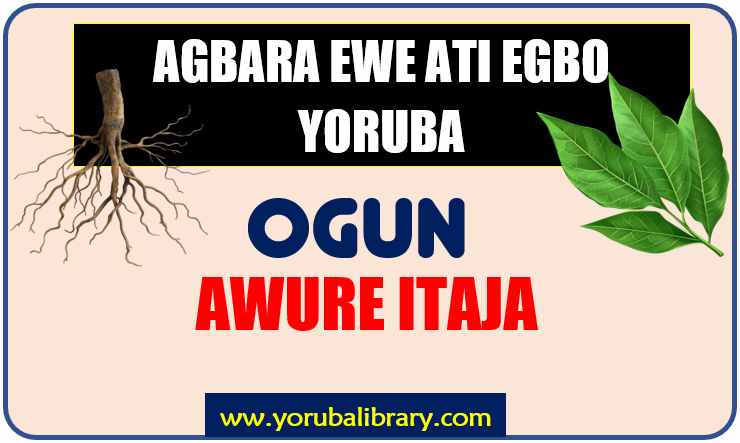
support@yorubalibrary.com
+2348073529208, 07038599574


Among the Yoruba people, the health of the legs is highly valued because they carry the body and enable movement. When the leg becomes swollen (ẹsẹ̀ wíwú), it is considered a serious condition that can limit mobility, cause pain, and reduce a person’s ability to work or participate in daily life. Unlike minor bruises or temporary fatigue, swelling of the leg was treated by Yoruba forefathers as a condition that required careful observation and healing.
Swollen legs may arise from different causes: injury, overwork, standing for long hours, or hidden internal imbalance. Our forefathers paid attention not only to the physical discomfort but also to how such swelling could disrupt a person’s productivity and dignity in the community. Traditional medicine was therefore directed at reducing the swelling, easing the pain, and restoring the leg to its natural state using plant-based remedies.
The Yoruba healing system relied heavily on the gifts of nature—roots, leaves, barks, and herbs—to address swelling. These were selected for their cooling, soothing, and anti-inflammatory properties. Remedies were applied externally through washes, poultices, and massage oils, or internally through mild decoctions that helped cleanse the body of excess fluid. Such practices were handed down from one generation to another, proving effective in many cases of ẹsẹ̀ wíwú.
Disclaimer
Yoruba Library and its Team will not be held liable for improper usage or any loss arising from improper use, wrong application, inability to find needed materials, or misinterpretation of this article. This article is provided strictly for guidance and educational purposes.
Symptoms Observed by Our Forefathers
Yoruba healers watched for specific signs to determine when a swollen leg required treatment:
• Noticeable enlargement of one or both legs.
• Pain or discomfort when walking or standing.
• Skin tightness or shininess over the swollen area.
• Warmth or heaviness in the leg.
• Difficulty bending or moving the affected joint.
• In severe cases, inability to wear footwear due to swelling.
How Our Forefathers Treated Swollen Legs in the Past
The Yoruba approached ẹsẹ̀ wíwú using practical, plant-based remedies aimed at reducing inflammation and restoring balance:
• Herbal Remedy–
Leaves and barks with cooling effects were crushed, warmed slightly, and applied directly to the swollen leg to draw out heat and fluid.
Some notable plants used in treating Ese Wiwu in the past include:
1) Ewe Ina
2) Ewe Eyin Olobe
3) Ewe Ajeobale
4) Ewe Aiku
5) Ewe Ibepe
6) Ewe Gbegi
7) Ewe Abo-oganwo
8) Ewe Awede
Have you heard of Yoruba Herb Dictionary? This contains names of Yoruba Leaf, Roots, Barks, Characteristics, Properties & Identification with HD Pictures. Order below or download sample here
A-Z HERBS & LEAF DICTIONARY #4KOne Yoruba proverb says "Bí olóde ò kú, òde rè kì í wu Gbégi". Do you know that Gbégi is actually a leaf/plant? Get Yoruba Proverbs on Plants and Herbs, which is a collection of Untold Wisdoms Hidden in Leaf and plants comprising their Life Applications & Moral Teachings. Order below or download sample here
YORUBA PROVERBS ON PLANTS #4KThe Healing Process in Traditional Practice
Healing of ẹsẹ̀ wíwú was not rushed but carefully managed in steps:
• Timing of Herb Collection –
Leaves and roots were gathered at specific times of the day, usually early morning, to preserve freshness and healing strength.
• Preparation Method –
Materials were boiled, soaked, or crushed depending on whether they were intended for external wash, massage oil, or internal cleansing.
• Application and Monitoring –
The swollen leg was treated daily with poultices, washes, or massage. The healer observed changes in size, pain, and flexibility to adjust treatment.
• Consistency of Use –
Remedies were continued for several days or weeks until the swelling reduced and the leg regained natural strength and appearance.
Differences Between Yoruba and Modern Treatment
1) Focus of Healing – Yoruba medicine treated swollen legs by combining external herbal applications with internal cleansing, while modern practice often uses diuretics, compression stockings, or surgery.
2) Materials Used – Traditional practice relied on herbs, roots, and oils, while modern medicine uses pharmaceutical drugs and medical equipment.
3) View of Recovery – Yoruba healing emphasized restoring both strength and appearance, while modern treatment may focus more on reducing fluid or managing underlying disease.
Safety First: Important Contraindications and Considerations
• Pregnancy and Lactation –
Some cleansing herbs may be unsafe for pregnant or breastfeeding women and should be avoided.
• Underlying Conditions –
People with chronic illnesses such as kidney or heart problems must not take strong herbal decoctions without guidance.
• Source Quality –
Herbs must be obtained from clean, chemical-free environments to avoid contamination.
• Children and the Elderly –
Treatments for young children and aged persons must be milder and carefully supervised.
Needed Materials (Leaves, Roots, Bark, etc.)
The medicinal approach for this requires careful selection of natural materials traditionally known to our elders. These are combined to ensure potency.
The instruction you will receive is the original account of our forefathers, preserved and tested over time. Many people have used them with testimonies of relief. Just ensure you follow the correct guidelines. Click Unlock Secret below
Application Process
The strength of Yoruba medicine depends on how materials are handled. Proper pounding, boiling, or steeping — done in the right way and at the right time — ensures the remedy remains potent. Click Unlock Secret below
Uses
The prepared remedy must be applied in the correct manner — whether for drinking, steaming, bathing, or chest rubbing — and taken in the right dosage for it to remain effective.
1) Some leaf required special utterances/chants before they can be effective. Where applicable, this will be stated in the PDF
2) The methods of getting the needed items like leaf, bark, roots by yourself is covered in the PDF
3) Saa bi Ologun ti wi, ki o le baa je... (Follow instructions for it to remain potent). You're getting a Real and Original account of our fore fathers.
With Numerous Satisfied Clients...